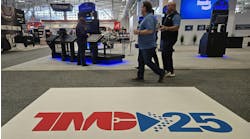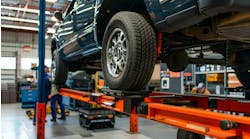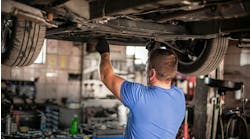Industry experts estimate that about 40 percent of engine downtime is caused by cooling system problems. Understanding the common problems and implementing proven preventative maintenance practices significantly reduces operating costs.
There are four major cooling system problems that result in unscheduled downtime, says Sean “Marty” Martinelli, OEM account manager at Penray. They are: cavitation-erosion, corrosion, scale and green goo or drop-out.
Headquartered in Elk Grove Village IL, Penray has been the standard of excellence in cooling and fuel system treatments that maximize performance and help extend vehicle life.
CAVITATION-EROSION
“One of the most common and costly results of improper cooling system maintenance is the perforation of wet-sleeve cylinder liners, often referred to as cavitation-erosion or liner pitting,” says Martinelli. “The perforation is caused by repetitive pitting of the liner as a result of liner vibration.”
As the fuel inside ignites, the liner vibrates within the block, he explains. The outside wall of the liner actually moves away from the coolant causing a near vacuum for an instant. This low pressure causes the surrounding coolant to boil, forming tiny bubbles.
“The liner then returns to its position at extremely high velocity, pressing against the bubbles with a violent force,” says Martinelli. “The bubbles implode against the liner wall surface at pressures up to 60,000 psi. The collapse of these bubbles blasts small holes in the cast iron liner.”
This pitting process will repeat, digging tiny tunnels through the liner. Eventually, the liner wall will become perforated, allowing coolant to enter the combustion side of the cylinder, he says.
“If coolant enters the combustion side of the cylinder, an expensive in-frame overhaul is required. Cavitation-erosion is not usually covered under engine warranties and can take a significant bite out profits.”
CORROSION CONDITIONS
Corrosion - the natural tendency of metals to revert back to their ore form - is another problem with an unmaintained cooling system, says Martinelli. A number of conditions in a cooling system will affect the degree and rate at which metal surfaces corrode. These include:
- Coolant pH.
- Concentration of dissolved oxygen and carbon dioxide.
- Metal surface deposits.
- Metal stress.
- Coolant temperature.
- Corrosion inhibitors present.
“All the metals in a cooling system will corrode under certain conditions,” he notes. “Some metals are more sensitive than others. When metals corrode they weaken, and the component will eventually fail.”
The metal most prone to corrosion in a cooling system environment is aluminum, says Martinelli. Cast iron, solder, steel, copper and brass will also corrode.
WATER SCALE
Hard water scale can block a cooling system’s ability to transfer heat, resulting in overheating.
A diesel engine generates enough heat to warm a seven-room house during the winter, he says. The engine must shed some of this heat to operate efficiently and prevent severe component damage.
“Two-thirds of this heat is lost through the exhaust and through the engine work. The remaining third must be pulled from an engine by the cooling system.
“It is critical that all cooling system heat exchange surfaces remain clean,” he goes on. “Only 1/16 inch of scale will reduce cooling system heat transfer efficiency by 40 percent.”
Martinelli says cooling system problems that result from overheating caused by scale are:
- Severe pitting of the wet sleeve liners.
- Cracked heads and warped engine blocks.
- Oil temperature running abnormally high.
- Failure of the cooling system fan to turn on.
- Scale deposits on cooling system block heaters.
- Corrosion of the steel and cast iron surfaces.
- Hard water scale build-up on the cold side of the liner, creating an insulating effect and consequent hot spots.
- Fouling of the heater core with silica gel and phosphate sludge, resulting in reduced heat to the cab and bunk heaters.
- Corrosion of the water pump impellers.
- Thermostat malfunctions.
- Gel insulates fan temperature sensors, causing improper air fan operation resulting in overheating.
- Fouling of the radiator with silica gel of phosphate sludge from the antifreeze.
- Solder corrosion and consequent solder bloom fouling.
- Corrosion of the copper or aluminum radiator core.
- Water pump seal failure due to excess dissolved solids and/or high phosphate levels.
- Water pump cavitation due to foaming.
- Short-outs in block heater due to phosphate scale buildup.
DROP-OUT
The potential for scale formation on hot metal cooling system surfaces is affected by a number of dynamic conditions, says Martinelli: By way of example: the harder the water being used in an engine coolant, the greater the potential for scale formation. As coolant temperatures increase, hardness salts (calcium and magnesium) in solution have the potential to plate out on hot metal cooling system surfaces.
“Flow characteristics are an important consideration as scale generally forms on the hot side of a cooling system and in areas of low or turbulent flow,” he says. “Entrapped air can also be a problem as any air bubble formation in a coolant area - bubbling around a hot source - increases the tendency for scale to form in that area. High pH will increase the potential for scale deposits as well.”
Lastly, there can be damage to water pump seals.
Calcium and magnesium have the tendency to combine with the phosphates found in low grade antifreeze and some additive packages, explains Martinelli. They form calcium and magnesium phosphate scale on heat transfer surfaces, especially on water pump seal faces.
“These deposits can distort the flatness of a seal face, preventing the water pump seal from sealing. The result can be leaking water pumps.”
There is also the matter of green goo or drop-out, which happens when additives, especially silicates, get too concentrated and drop out of the liquid, forming green goo. This can also lead to water pump failure, as well as radiator blockages and heater core problems.
COOLANT CHECKS
Now that you know what happens if a cooling system is not properly maintained, what should you look for when checking coolant?
Coolant color is important, Martinelli says, as coolant can come in green, pink, red, blue, yellow, orange and even brown.
“The color of the coolant is one indicator as to what kind of coolant you have and how it is to be maintained. Mixing of technologies and not maintaining them correctly can lead to cooling system problems.
“While coolant comes in many different colors, they have one thing in common: they should all be clear.
If the coolant appears cloudy or has particulates floating in it, this could be a sign of bigger problems. “Clarity is a major concern.”
Properly maintained coolant should have a freeze point of -34 degrees Fahrenheit, warns Martinelli. This indicates there is the proper 50/50 mix of antifreeze and water.
“Too much antifreeze can lead to water pump failures, drop-out and improper cooling of the engine. Maintain the freeze point between -25 degrees and -50 degrees Fahrenheit for optimum performance.”
Chemical levels also must be maintained and monitored in the coolant, he says. Depending on the type of coolant in the engine, there are different maintenance practices that must be adhered to in order to keep the unit running.
“Coolant is indeed a hot topic these days,” concludes Martinelli. “With all the different colors and chemistries available, it is more important than ever to ensure a proper cooling system maintenance program.
“As mentioned earlier, an estimated 40 percent of engine downtime is caused by cooling system problems, but take comfort in the fact that cooling system problems are virtually 100-percent preventable.”
SERVICING EQUIPMENT
Two commonly used cooling system service machines are coolant flushers and coolant exchangers.
Basically, the primary purpose of a coolant flushing machine is to remove old, spent coolant from a vehicle’s cooling system, clean out the radiator and coolant system of debris and rust and replenish the system with new coolant, says Jim O’Hara, vice president of marketing at Clore Automotive, a manufacturer of automotive service equipment.
These functions are achieved by draining the old coolant, introducing and circulating a cleaning solution throughout the coolant system, evacuating that solution along with the contaminants it absorbed and adding new coolant into the system, explains Chris Rogers, a marketing official with Qwik Draw, a provider of automotive fluid exchange equipment.
This mechanical flush is a more complete service, O’Hara notes. Significantly more of the old coolant is removed and replaced than if a traditional drain and fill were performed. Because most coolant flushing machines utilize pressure to agitate the system, a greater amount of contamination and debris is removed from the system than with a traditional service.
If coolant exchange is done routinely, the rust and scaling inhibitors of the coolant have not deteriorated beyond their useful life and the coolant system is still clean, says Rogers. Plus, more readily recyclable used coolant is extracted.
Coolant flushing and coolant exchange machines can provide a number of benefits to maintenance operations, says Gary Hutchison, vice president, sales and marketing, for Symtech Corporation, a manufacturer of automotive equipment. Among them: faster servicing with reduced vehicle downtime than traditional methods; more efficient draining, contaminant removal and coolant replenishment; and avoiding coolant spills.
PURCHASE CONSIDERATIONS
When looking to acquire coolant flushing and fluid exchange machines, there are a number of factors to analyze. The starting point is to make certain the machine will meet the shop’s specific service needs. Here is some additional advice.
- Clore Automotive’s O’Hara says things to consider are:
+ Simple equipment operation.
+ Easy conversion between different styles of coolant.
+ Variable exchange speed control.
+ Ease of connection and verifying fittings and adapters complete enough to service the specific vehicles the shop will encounter.
+ Power required to operate the machine.
+ Level of after-sale service and support and training assistance.
+ Warranty coverage and term.
- Qwik Draw’s Rogers says key factors are:
+ Longevity of the manufacturer and its reputation.
+ Equipment that uses both vacuum and pressure. (“This results in faster and more complete exchange of fluid.”)
+ Safety, ease of use and speed of the equipment.
- Symtech Corporation’s Hutchison suggests keeping in mind:
+ Quality of the equipment.
+ Service features that technicians recognize as benefits and make their job easier.
+ Can the equipment perform multiple services?




